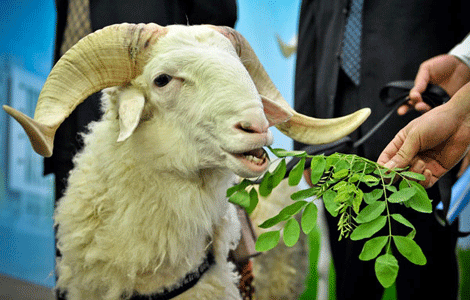
China's GDP for the first time passed $8 trillion, or about 55 percent the size of the US economy, after the world's second-largest economy struggled to speed up growth in the fourth quarter.
Based on yearly growth of 7.8 percent, the government announced on Friday that the country's 2012 GDP was 51.9 trillion yuan ($8.28 trillion).
GDP grew 7.9 percent in the final quarter, compared with 7.4 percent in the third and 7.6 percent in the second.
China's growth continued to be the highest among leading world economies, although it was its slowest in 13 years.
What was special about the year, according to Ma Jiantang, chief of the National Bureau of Statistics, was that consumption surpassed investment to become the largest contributor to the economy's growth. Its contribution to GDP was 51.8 percent, opposed to 50.4 percent from capital investment, while the contribution from net exports was minus 2.2 percent.
Rather than chasing an increasing speed of growth, the government has been focused on rebalancing the economy and improving its growth model, Ma said. Progress was achieved in the economy's structural adjustment, he said.
The Chinese economy is likely to grow steadily in 2013 and maintain an annual growth rate between 7 and 8 percent in the long term, Ma said.
Lian Ping, chief economist with the Bank of Communications, said that investment will be the main driving force for growth.
Investment is expected to increase faster and the housing market, now under government curbs, may be showing a stronger tendency to rise, he said.
Lian predicted that GDP growth may accelerate to 8.5 percent in 2013.
Steve Tsang, professor of Contemporary Chinese Studies at the University of Nottingham, hailed China's 2012 performance as "impressive". The growth "is actually on par with what the Chinese government has wanted", he said.
The more important issue is where the growth comes from, he said.
China's economy has relied heavily on infrastructure spending since the outbreak of the global financial crisis in 2008. But the country is now trying for a transition into a consumption-driven economy.
"It is encouraging to see from today's figure that a lot of the growth comes from retail sales, which means domestic consumption is growing," Tsang said.
The biggest challenge of further increasing domestic consumption is the need for the government to maintain a high rate of employment and growth, Tsang said.
"This is easy to achieve through capital growth, but much harder to achieve through consumption growth, as people may choose not to spend even if their incomes increase," he said.
JPMorgan revised its forecast of 2013 GDP to 8.2 percent from 8 percent on Friday, cheered by the better-than-expected economic indicators in the fourth quarter.
"The solid growth in the fourth quarter suggests that the momentum of economic recovery continued to firm up," said Zhu Haibin, JPMorgan's chief China economist. "The domestic factors are likely to play a more important role in supporting economic growth in the first half of 2013."
He expected that the consumer price index, a main gauge of inflation, may trend up to an average of 3.2 percent this year amid the modest economic recovery, compared with the full-year CPI of 2.6 percent in 2012.
"The central bank is expected to keep policy rates on hold throughout the year, while continuing to run a fiscal deficit and expand structural tax cuts to support targeted sectors, including services and new strategic industries," Zhu said.
Among the economic data released by the National Bureau of Statistics, the working-age population decreased for first time, with the number of people between 15 and 60 shrinking by 3.45 million from 2011 to 937.2 million last year, adding concerns of a labor shortage.
"The working-age population may continue to shrink steadily, but China will retain labor advantages. It is urgent to improve the labor force quality and promote social productivity," said Ma, chief of the National Bureau of Statistics.
Contact the writers at chenjia1@chinadaily.com.cn and cecily.liu@chinadaily.com.cn







